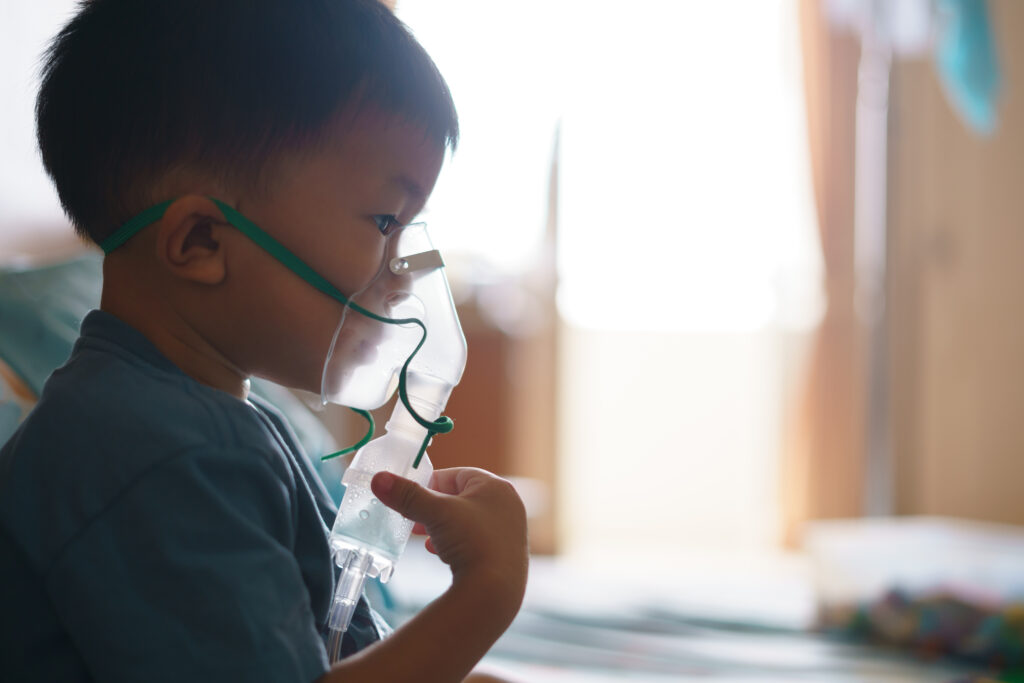As we head into the winter months, respiratory viral infections begin to rise. This year, human metapneumovirus is poised to make an impact.
Winter is coming ‒ together with an expected wave of respiratory viral infections. Influenza viruses, SARS-CoV-2, and respiratory syncytial virus (RSV) will again predominate, but a recent outbreak in China highlighted the lesser known but important human metapneumovirus (hMPV), which is related to RSV, and completes the gang of four. hMPV will also play a significant role this winter in Australia.
What happened in China?
In late 2024, China reported outbreaks of unidentified respiratory infections, particularly in young children and the elderly resulting in some hospitals being overwhelmed. This surge raised fears of another corona virus disease 19 (COVID-19)-like pandemic as the timing echoed what happened in 2019 when cases of unidentified respiratory infections spiked just before the new year period when hundreds of millions of people travel within China for celebrations. However, authorities in China considered the surge of respiratory infections to be within expectations for the winter season.
Chinese scientists used their well established sentinel surveillance system for respiratory infections and identified hMPVs as being responsible. The surge was attributed to decreased population immunity due to prolonged COVID restrictions, resulting in more hMPV infections. The detection of hMPV underscores the need for continued awareness and preparedness for respiratory infections beyond SARS-CoV-2; for example, in late 2023 surges of Mycoplasma pneumoniae infections were reported in China resulting in illness and hospitalisations, mainly in children.
The prompt detection of hMPV in China also highlights the importance of having robust global surveillance systems for respiratory pathogens. Enhanced surveillance facilitates early detection as well as the monitoring of genomic information, through genetic databases such as GISAID and Nextstrain. This leads to the early development of diagnostic tests as well as vaccines to novel agents, as we saw in the recent COVID-19 pandemic. Virus evolution and mutations can also be monitored through such databases.
hMPV outbreaks in China have occurred frequently and were first documented in 2003. Analyses of 56 representative studies focusing on hMPV epidemiology in China from 1 January 2003 to 31 December 2023, showed a 4.70% positive rate for hMPV from 188 104 clinical samples among patients with acute respiratory illness. The vast majority of cases in these reports were in patients under 5 years of age and the virus was more prevalent in spring and winter.

Origins
In 2001, a research team in the Netherlands were the first to discover hMPV. Subsequently, the prevalence of hMPV has been documented in many countries and it is now considered an important cause of respiratory tract infections worldwide.
hMPV is an enveloped RNA virus belonging to the Pneumoviridae family and the genus Metapneumovirus and is closely related to avian metapneumovirus. RSV is also in the same family. hMPV likely emerged between 119 and 133 years ago. There are now six main genetic lineages of hMPV co-circulating globally (A1, A2a, A2b, A2c, B1 and B2) with two lineages A2.2.1 and A2.2.2 emerging in paediatric cases in India.
Disease burden
hMPVs affect all age groups, especially young children, the elderly, and immunocompromised individuals and has been implicated in exacerbations of chronic respiratory conditions, including asthma and chronic obstructive pulmonary disease (COPD). hMPV accounts for some 5% to 10% of hospitalisations in children suffering from acute respiratory tract infections.
Clinical manifestations are similar to other respiratory viral infections ranging from mild upper respiratory tract infections, with symptoms such as fever, cough, nasal congestion and wheezing, to severe infections such as bronchiolitis and pneumonia, sometimes leading to respiratory failure; however, while clinically indistinguishable from RSV, influenza and COVID-19, it is generally less severe than other respiratory viruses. Like other respiratory viruses, hMPV spreads primarily through droplets or aerosols from coughing, breathing and/or sneezing.
In children, aged 1 to 59 months, hMPV as a cause of severe pneumonia has been well established and was the second-ranked pathogen for severe pneumonia in The Pneumonia Etiology Research for Child Health (PERCH) case-control study in African and Asian nations. Among hMPV-positive cases, 65.2% were aged younger than 1 year and 27.5% had pneumonia danger signs but case fatality rates were relatively low, similar to RSV-positive cases.
In the Netherlands, seroprevalence studies show that nearly all children by age 5 years have been exposed to hMPV. Seasonal peaks of hMPV infections typically occur during winter and early spring aligning with the patterns generally observed for other respiratory viruses.
The disease burden due to hMPV in older adults aged 65 years or more is less well researched. However, a recent extensive review reported on the global burden of hMPV in older adults over the period from 2005 to 2023. During 2019, it was estimated that there were 473 000 hMPV-associated hospitalisations globally in people aged 65 years or older, and in the USA, 122 000 hospital admissions with a pooled hospitalisation rate of 231 per 100 000 people. The data showed that hMPV can contribute to a substantial disease and hospitalisation burden in older adults. However, more large scale surveillance studies will enable us to develop more reliable estimates.
In Australia the incidence of hMPV is unknown but some sentinel general practice sites showed that in 2024, 7.8% of people who presented with fever and cough symptoms were positive for hMPV. Moreover, Western Australia saw a significant increase in paediatric hMPV infections in mid-2021, especially in children aged 1 to 4 years, following the relaxation of COVID-19 restrictions.
In 2025, data from the UK showed a hMPV positivity rate of 4.8% to 10.8% among children under 5 years old and from 2022 to 2024, hMPV was identified as a substantial contributor to paediatric lower respiratory tract infections. Across Europe, hMPV continues to display seasonality in late winter and spring and is a significant cause of acute respiratory infections in adults over 60 years, with a disease burden comparable to influenza.
Diagnostic methods
Because respiratory illnesses present with similar symptoms, diagnostic tests are needed to identify the aetiological agent as the treatment can differ eg, COVID-19 and influenza have specific antiviral treatment options.
A variety of rapid diagnostic tests have been developed in recent years for hMPV and other respiratory agents. Molecular techniques such as reverse transcription-polymerase chain reaction (RT-PCR) remain the gold standard for hMPV detection but other sensitive platforms are also used such as quantitative RT-PCR (RTqPCR) and loop-mediated isothermal amplification methods (LAMP). All have high sensitivity and specificity.
Virus isolation from the clinical samples in cell cultures is the gold standard for pathogen diagnosis and can help to fulfill Koch’s postulates of causation. Moreover, it is generally the first step for determining viral pathogenesis, subsequent research and vaccine development. Human Chang conjunctiva (clone 1-5C4), LLC-MK2, and feline kidney CRFK cell lines are all used for hMPV cultivation.
Treatment options and vaccines
There are no approved vaccines or specific antiviral therapies for hMPV infection as yet and management is focused on symptom relief and maintenance of adequate oxygenation and hydration. Antipyretics and steroids can reduce inflammation and ease symptoms. However, ribavirin (oral and aerosolised) together with intravenous immunoglobulin may be an effective treatment option for severe cases especially in immunocompromised patients. Monoclonal antibodies to hMPV used prophylactically may also prove to be useful, especially in high risk patients, and would be analogous to the use of nirsevimab/palivizumab for RSV.
Vaccines are being explored including live-attenuated, subunit, mRNA and vector-based platforms. The University of Queensland announced a clinical trial in November 2024 for a newly developed vaccine candidate targeting respiratory diseases, including hMPV. Another Australian trial combines RSV vaccine with an hMPV component to investigate protection against these two respiratory viruses.
Standard infection control practices, including hand hygiene, respiratory etiquette, and isolation of infected individuals, are effective in reducing hMPV transmission. Such measures are particularly important in communal environments such as health care settings.
Final word
hMPV remains a pathogen of considerable concern and a pandemic candidate. The burden of hMPV on public health systems is considerable, given its role in respiratory illnesses across diverse populations. The recent surge in cases in China serves as a reminder of the virus’s potential impact, particularly in paediatric and geriatric cohorts. In Australia, continuous surveillance is essential to monitor hMPV activity, to promptly identify and respond to any atypical patterns of transmission. Outside the gang of four, other viruses are also expected to surge this winter, including paramyxoviruses, adenoviruses, enteroviruses and rhinoviruses. Vaccine preventable diseases like pertussis, pneumococcal, meningococcal, and measles are also likely to surge due to under-vaccination. All need to be carefully monitored.
Gary Grohmann is former Director of Immunobiology and WHO Essential Regulatory Laboratory at the Therapeutic Goods Administration. He currently works as an independent consultant, primarily with the WHO on influenza-related projects in the Global Influenza Programme and the Essential Medicines Programme.
Professor Robert Booy is an infectious diseases paediatrician. He is a Senior Professorial Fellow at the University of Sydney Children’s Hospital Westmead Clinical School.
Gratitude to Dr John McEwen for reviewing the manuscript.
The statements or opinions expressed in this article reflect the views of the authors and do not necessarily represent the official policy of the AMA, the MJA or InSight+ unless so stated.
Subscribe to the free InSight+ weekly newsletter here. It is available to all readers, not just registered medical practitioners.
If you would like to submit an article for consideration, send a Word version to mjainsight-editor@ampco.com.au.

 more_vert
more_vert